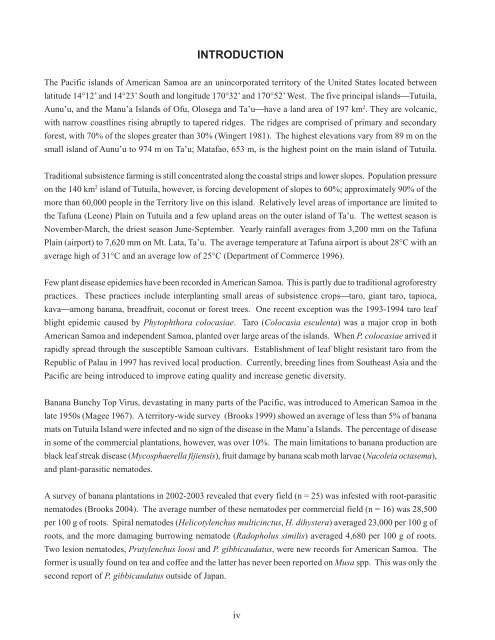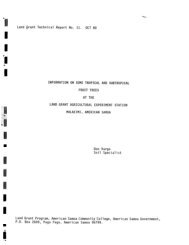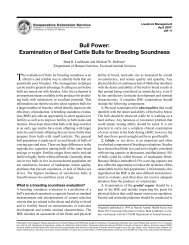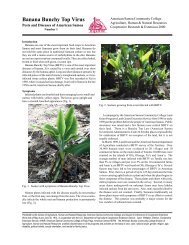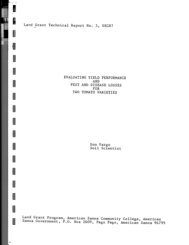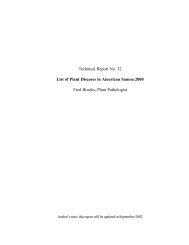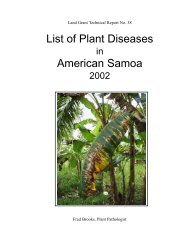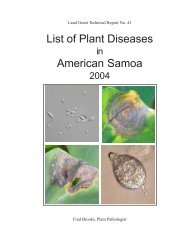List of Plant Diseases - College of Tropical Agriculture and Human ...
List of Plant Diseases - College of Tropical Agriculture and Human ...
List of Plant Diseases - College of Tropical Agriculture and Human ...
You also want an ePaper? Increase the reach of your titles
YUMPU automatically turns print PDFs into web optimized ePapers that Google loves.
INTRODUCTION<br />
The Pacific isl<strong>and</strong>s <strong>of</strong> American Samoa are an unincorporated territory <strong>of</strong> the United States located between<br />
latitude 14°12’ <strong>and</strong> 14°23’ South <strong>and</strong> longitude 170°32’ <strong>and</strong> 170°52’ West. The five principal isl<strong>and</strong>s⎯Tutuila,<br />
Aunu’u, <strong>and</strong> the Manu’a Isl<strong>and</strong>s <strong>of</strong> Ofu, Olosega <strong>and</strong> Ta’u⎯have a l<strong>and</strong> area <strong>of</strong> 197 km2 . They are volcanic,<br />
with narrow coastlines rising abruptly to tapered ridges. The ridges are comprised <strong>of</strong> primary <strong>and</strong> secondary<br />
forest, with 70% <strong>of</strong> the slopes greater than 30% (Wingert 1981). The highest elevations vary from 89 m on the<br />
small isl<strong>and</strong> <strong>of</strong> Aunu’u to 974 m on Ta’u; Matafao, 653 m, is the highest point on the main isl<strong>and</strong> <strong>of</strong> Tutuila.<br />
Traditional subsistence farming is still concentrated along the coastal strips <strong>and</strong> lower slopes. Population pressure<br />
on the 140 km2 isl<strong>and</strong> <strong>of</strong> Tutuila, however, is forcing development <strong>of</strong> slopes to 60%; approximately 90% <strong>of</strong> the<br />
more than 60,000 people in the Territory live on this isl<strong>and</strong>. Relatively level areas <strong>of</strong> importance are limited to<br />
the Tafuna (Leone) Plain on Tutuila <strong>and</strong> a few upl<strong>and</strong> areas on the outer isl<strong>and</strong> <strong>of</strong> Ta’u. The wettest season is<br />
November-March, the driest season June-September. Yearly rainfall averages from 3,200 mm on the Tafuna<br />
Plain (airport) to 7,620 mm on Mt. Lata, Ta’u. The average temperature at Tafuna airport is about 28°C with an<br />
average high <strong>of</strong> 31°C <strong>and</strong> an average low <strong>of</strong> 25°C (Department <strong>of</strong> Commerce 1996).<br />
Few plant disease epidemics have been recorded in American Samoa. This is partly due to traditional agr<strong>of</strong>orestry<br />
practices. These practices include interplanting small areas <strong>of</strong> subsistence crops⎯taro, giant taro, tapioca,<br />
kava⎯among banana, breadfruit, coconut or forest trees. One recent exception was the 1993-1994 taro leaf<br />
blight epidemic caused by Phytophthora colocasiae. Taro (Colocasia esculenta) was a major crop in both<br />
American Samoa <strong>and</strong> independent Samoa, planted over large areas <strong>of</strong> the isl<strong>and</strong>s. When P. colocasiae arrived it<br />
rapidly spread through the susceptible Samoan cultivars. Establishment <strong>of</strong> leaf blight resistant taro from the<br />
Republic <strong>of</strong> Palau in 1997 has revived local production. Currently, breeding lines from Southeast Asia <strong>and</strong> the<br />
Pacific are being introduced to improve eating quality <strong>and</strong> increase genetic diversity.<br />
Banana Bunchy Top Virus, devastating in many parts <strong>of</strong> the Pacific, was introduced to American Samoa in the<br />
late 1950s (Magee 1967). A territory-wide survey (Brooks 1999) showed an average <strong>of</strong> less than 5% <strong>of</strong> banana<br />
mats on Tutuila Isl<strong>and</strong> were infected <strong>and</strong> no sign <strong>of</strong> the disease in the Manu’a Isl<strong>and</strong>s. The percentage <strong>of</strong> disease<br />
in some <strong>of</strong> the commercial plantations, however, was over 10%. The main limitations to banana production are<br />
black leaf streak disease (Mycosphaerella fijiensis), fruit damage by banana scab moth larvae (Nacoleia octasema),<br />
<strong>and</strong> plant-parasitic nematodes.<br />
A survey <strong>of</strong> banana plantations in 2002-2003 revealed that every field (n = 25) was infested with root-parasitic<br />
nematodes (Brooks 2004). The average number <strong>of</strong> these nematodes per commercial field (n = 16) was 28,500<br />
per 100 g <strong>of</strong> roots. Spiral nematodes (Helicotylenchus multicinctus, H. dihystera) averaged 23,000 per 100 g <strong>of</strong><br />
roots, <strong>and</strong> the more damaging burrowing nematode (Radopholus similis) averaged 4,680 per 100 g <strong>of</strong> roots.<br />
Two lesion nematodes, Pratylenchus loosi <strong>and</strong> P. gibbicaudatus, were new records for American Samoa. The<br />
former is usually found on tea <strong>and</strong> c<strong>of</strong>fee <strong>and</strong> the latter has never been reported on Musa spp. This was only the<br />
second report <strong>of</strong> P. gibbicaudatus outside <strong>of</strong> Japan.<br />
iv


